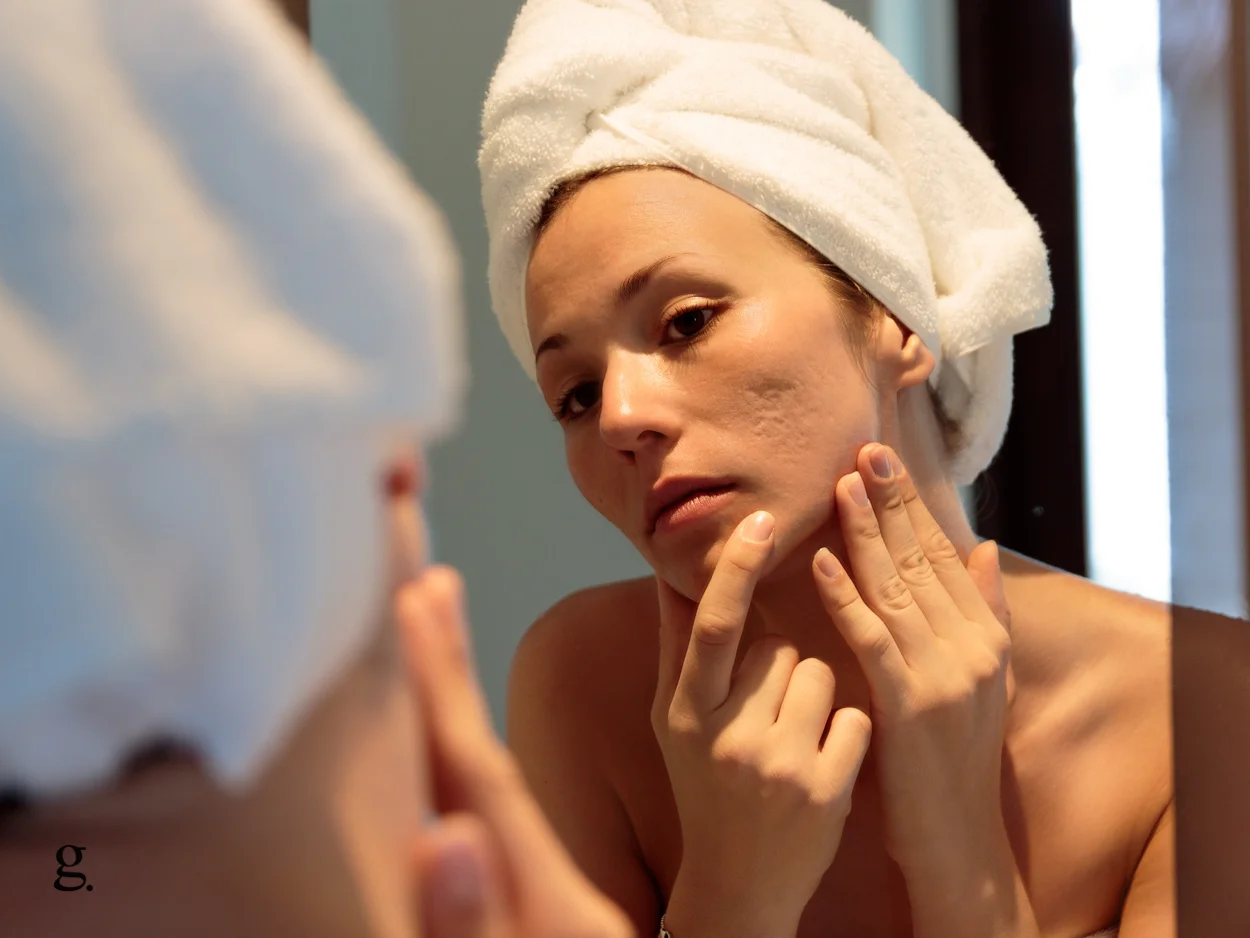Ah, acne scars—the bane of many a skincare enthusiast’s existence. You’ve finally waved goodbye to those pesky breakouts, only to be left with a not-so-pleasant reminder of their presence. Luckily, getting rid of acne scars doesn’t have to be a pipe dream.
Why does acne cause scarring?
When a breakout rears its ugly head, it can cause some serious chaos beneath the skin’s surface. Inflammation plays a big role here, as it triggers your body’s immune response to help repair the damage caused by acne.
Now, your body is pretty amazing—it kicks into high gear, producing collagen to mend the damage done by the inflammation. However, sometimes things don’t go exactly as planned. If too little collagen is produced, you might end up with a depressed or pitted scar. On the flip side, if your body goes a little overboard with collagen production, you could end up with a raised or hypertrophic scar.
But wait, there’s more! Acne scarring can also be the result of popping or picking at your zits (guilty as charged, we’ve all been there). When you mess with your breakouts, you’re not only introducing bacteria, but you’re also causing more trauma to the skin. This can lead to a longer healing process and increase the likelihood of scarring. So let this be a gentle reminder: hands off those pimples.
Before we move forward to the how-tos, it’s important to know that not all acne scars are created equal. Here’s a quick rundown of the different types of acne scars you might encounter:
- Ice pick scars: These are small, deep, and narrow scars that resemble—you guessed it—tiny ice pick holes. They usually occur when an infected pore or hair follicle causes damage deep within the skin.
- Boxcar scars: These scars have defined edges and a somewhat boxy appearance. They tend to be wider and shallower than ice-pick scars and typically result from inflammation that has destroyed collagen in the skin.
- Rolling scars: With their wavy, rolling appearance, these scars are caused by bands of scar tissue forming beneath the skin’s surface. This pulls the skin downward, creating an uneven texture.
- Atrophic scars: These are flat, shallow scars that are slightly indented below the skin’s surface. They occur when there’s a loss of tissue due to the body’s inability to produce enough collagen during the healing process.
- Hypertrophic scars: Unlike atrophic scars, hypertrophic scars are raised and firm. They form when the body produces too much collagen, resulting in a buildup of scar tissue above the skin’s surface.
- Keloid scars: Similar to hypertrophic scars, keloids are raised, but they tend to be larger and can extend beyond the original site of the acne. They occur when the body’s healing process goes into overdrive, causing an excessive buildup of scar tissue.
1. Dermabrasion
First up on our list of acne scar treatments is dermabrasion. This tried-and-true technique involves using a high-speed rotating instrument—think of it as a super-charged exfoliator—to sand away the outer layers of the skin. By removing the top layers, dermabrasion encourages the growth of new, smoother skin to take its place. It’s a pretty intense procedure that requires local anesthesia or numbing cream, but the results can be impressive.
Dermabrasion works best on shallow scars, like those caused by boxcars and atrophic scars. However, it might not be the best option for deeper scars like ice pick or rolling scars. It’s important to remember that the treatment can be quite aggressive, so it’s not ideal for those with sensitive or easily irritated skin. Plus, you’ll need to be prepared for some downtime, as your skin will likely be red and tender for a few weeks following the procedure.
2. Laser Skin Resurfacing
Next on the acne scar-fighting agenda is laser skin resurfacing. This high-tech treatment uses focused light beams to precisely remove the skin’s outer layers while stimulating collagen production in the deeper layers. As new skin forms, those pesky scars become less noticeable, making way for a more even complexion.
There are two main types of lasers used for skin resurfacing: ablative and non-ablative. Ablative lasers are more intense, vaporizing the outer layers of skin to trigger the growth of new, smoother skin. Non-ablative lasers, on the other hand, are less invasive, as they target the deeper layers of the skin to promote collagen production without damaging the surface.
Laser skin resurfacing can be effective for various types of acne scars, from shallow atrophic scars to deeper ice pick and rolling scars. However, the treatment’s success will depend on the individual’s skin type, scar severity, and the chosen laser. It’s worth noting that laser treatments can be pricey and may require multiple sessions for optimal results. Plus, there can be some downtime involved, particularly with ablative lasers, as your skin will need time to heal and regenerate.
3. Microneedling
Microneedling, also known as collagen induction therapy, is another popular option for tackling acne scars. This minimally invasive treatment involves the use of a device equipped with tiny needles that create controlled micro-injuries to the skin. These micro-injuries jumpstart the skin’s natural healing process, boosting collagen and elastin production, which in turn helps to fill in and smooth out acne scars.
Microneedling can be a good choice for a variety of acne scars, from shallow atrophic and boxcar scars to deeper rolling scars. It’s generally well-tolerated, and because the needles don’t go too deep, it’s suitable for most skin types, including those with more sensitive skin. Plus, microneedling has the added bonus of improving the skin’s overall texture and tone, so you’ll likely see an all-around glow-up!
The treatment typically requires multiple sessions for the best results, and while there’s less downtime compared to more aggressive treatments like dermabrasion or ablative lasers, you can still expect some redness and mild swelling for a few days post-treatment.
4. Chemical facial peel
Let’s talk chemical facial peels, another acne scar-fighting contender. These treatments involve the application of a chemical solution—typically composed of alpha hydroxy acids (AHAs), beta hydroxy acids (BHAs), or trichloroacetic acid (TCA)—to the skin. The solution exfoliates the top layers of the skin, causing them to peel off, and reveals fresh, smoother skin underneath.
Chemical peels come in a range of strengths, from mild over-the-counter options to more intense, in-office treatments. Lighter peels can help improve skin texture and reduce the appearance of shallow acne scars, while medium to deep peels can penetrate further into the skin to target deeper scars. Keep in mind, though, that deeper peels often come with more downtime and a higher risk of side effects, like redness, peeling, and even scarring if not done correctly.
While chemical peels can be effective for some types of acne scars, they may not be the best solution for everyone, especially those with sensitive skin or deeper scars like ice-pick scars. As with any skincare treatment, it’s crucial to consult with a qualified professional, such as a dermatologist or licensed aesthetician, to determine if a chemical peel is a right fit for your scarring situation and skin type.
5. Dermal fillers
Dermal fillers are yet another option for addressing acne scars, particularly those that are shallow and depressed, like atrophic or boxcar scars. These injectable treatments involve using a gel-like substance, such as hyaluronic acid or collagen, to fill in the indentations left by the scars, creating a smoother and more even appearance.
One of the perks of dermal fillers is their ability to provide immediate results. However, it’s important to note that these results are typically temporary, as the body will naturally break down and absorb the filler over time. Depending on the specific filler used, the results can last anywhere from several months to a couple of years. To maintain a smoother appearance, you’ll need to have follow-up treatments.
Dermal fillers may not be the best solution for all types of acne scars, like raised or hypertrophic scars, and they might not be suitable for everyone. There’s also a risk of side effects, such as bruising, swelling, or infection, so it’s crucial to choose an experienced, board-certified dermatologist or plastic surgeon to perform the procedure.
Conclusion
Acne scars are a common and often unavoidable side effect of acne blemishes.
Thankfully, you aren’t stuck with your scars; there are several treatment options available, with the most popular being dermabrasion, laser skin resurfacing, and microneedling (also known as collagen induction therapy).
The best way to prevent acne scars is to address your acne directly – think of it as a preemptive measure: have a good cleansing routine, don’t pick or squeeze your acne zits, and look into topical spot treatments for milder cases of acne.

